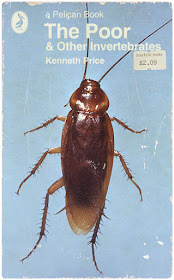Scarfolk Council was no stranger to invading the privacy of ordinary families. Back in December we introduced you to the council Christmas Boy (see HERE) who strictly monitored the contentment of families during the festive season. We've since received letters asking how the council kept households in check during the rest of the year.
In 1973 the council engineered a genetically modified creature called Roy. He was the result of cross-breeding barn owls with surplus human infants raised by prying, judgemental, lower-middle-class parents. Roy was cloned and delivered to every family in Scarfolk. His job was to oversee domestic affairs, and, if any family member deviated from officially sanctioned activity, Roy was to berate them by tutting and shaking his head.
Unfortunately, there had been a clinical oversight. Volatile poltergeist DNA had accidentally contaminated Roy's genes when a careless scientist left open a lab window which looked out onto a supernatural-energy processing plant. Instead of the envisioned tutting and head-shaking, Roy flew into violent rages, triggering major telekinetic events. There were reports of Roys decimating entire families and, in one case, allegedly annihilating an entire housing estate.
The council was under pressure to recall the defective owls, but because there had been a sudden drop in the numbers of families claiming benefits, it announced instead that Roy was a resounding success and millions more of the human-owl hybrid were commissioned by the police and social services.

Scarfolk is a town in North West England that did not progress beyond 1979. Instead, the entire decade of the 1970s loops ad infinitum. Here in Scarfolk, pagan rituals blend seamlessly with science; hauntology is a compulsory subject at school, and everyone must be in bed by 8pm because they are perpetually running a slight fever. "Visit Scarfolk today. Our number one priority is keeping rabies at bay." For more information please reread.
▼
Thursday, 30 July 2015
Thursday, 23 July 2015
Cub Scout "Bob-a-Body" Week (1977)
The annual boy scout Bob-a-Job week was an institution. However, from 1975 the jobs that scouts were expected to undertake moved away from the mundane - the washing of cars, sweeping of leaves and mowing of lawns - and became much more demanding.
Below is a scout leaflet from 1977 which was the first year that Bob-a-Job week officially changed its name.
During Bob-a-Body week, hundreds of cub scouts roamed Scarfolk helping members of the community with their assisted suicide needs. The old, sick and formally shunned most frequently employed the services of the scouts, though the council's Oxygen Resource Board allegedly sent lists of reluctant residents to scout groups in advance, along with illicitly duplicated front door keys and gallon jars of a toxic nerve agent.
Wednesday, 15 July 2015
Poverty & 1970s Pelican Books
Poor, uneducated people have always been obstinate in their selfish desire to ruin the contentment of those from more important social classes.
Below are several Pelican books from the 1970s which deal with the decade's poverty, austerity and the blight of these self-centered people who relish being destitute.
For example, The Poor and Other Invertebrates, published in 1974, made the following claims about the nation's impoverished:
"[They] reproduce prolifically in 3 months rather than the conventional 9 months of properly evolved humans".
"They intentionally contract diseases by manufacturing their own bacteria at home, which they smear onto their cheap linoleum floors [...] then roll around in it".
"They burgle respectable citizen's homes, then play Bingo".
In 1976, Scarfolk council dealt with the needy by taking away their autonomy and making them property of the state. Thousands of people below the breadline were requisitioned to be used as civic equipment such as street bollards and even sandbags in the case of flooding or terrorist bombings.
Below are several Pelican books from the 1970s which deal with the decade's poverty, austerity and the blight of these self-centered people who relish being destitute.
For example, The Poor and Other Invertebrates, published in 1974, made the following claims about the nation's impoverished:
"[They] reproduce prolifically in 3 months rather than the conventional 9 months of properly evolved humans".
"They intentionally contract diseases by manufacturing their own bacteria at home, which they smear onto their cheap linoleum floors [...] then roll around in it".
"They burgle respectable citizen's homes, then play Bingo".
In 1976, Scarfolk council dealt with the needy by taking away their autonomy and making them property of the state. Thousands of people below the breadline were requisitioned to be used as civic equipment such as street bollards and even sandbags in the case of flooding or terrorist bombings.
Thursday, 2 July 2015
"Mindborstal" Psychological Detention Drug
Following the publication of Children and Hallucinogens: The Future of Discipline in 1971, several products were developed by Cavalier Pharm, Scarfolk's largest pharmaceutical company.
In addition to Panopticon, a truth serum designed for minors (see Discovering Scarfolk p.65 for further details), Cavalier Pharm also manufactured a drug called Mindborstal which, as the advertisement above indicates, induced children into a mental state that functioned as a psychological prison.
The detention hallucinations produced by the drug were so potent that they were indistinguishable from reality and children under its influence sat motionless for days and even weeks, locked in delirious trances. They were convinced that they were incarcerated within physical spaces policed by intimidating entities tailored to their own personal fears.
Yet for all of the drug's obvious benefits, it was ultimately recalled when several children were reported to have escaped on imagined giraffes, which their subconscious psyches had somehow conjured into existence. At least, that was the official explanation. Sceptics weren't convinced, even when hundreds of dead giraffes conveniently washed up on Scarfolk beach. Recently leaked documents suggest that the real reason for the recall was a desperate attempt by the council to cover up its covert plan to have the drug renamed and introduced to the town's water supply.






